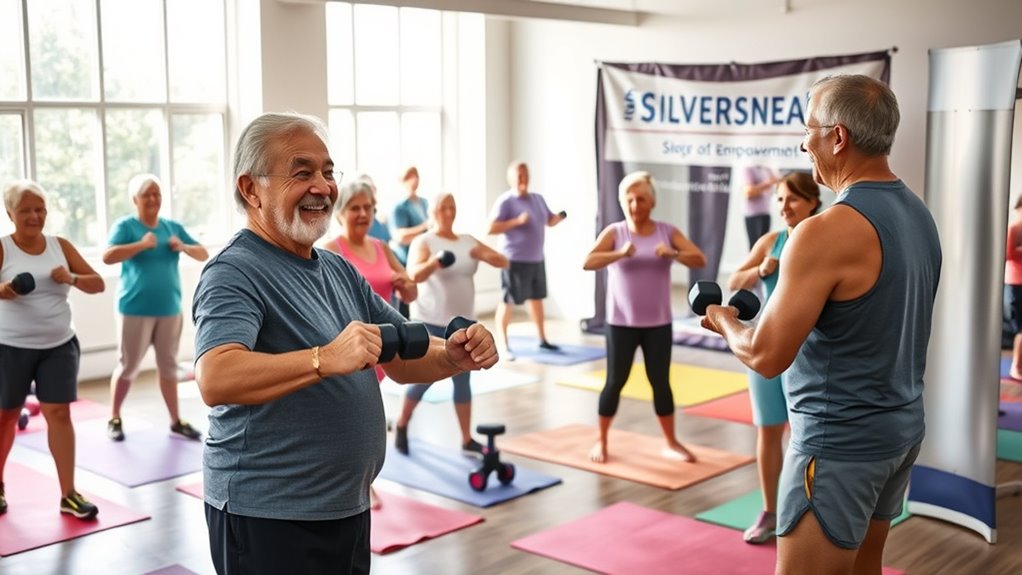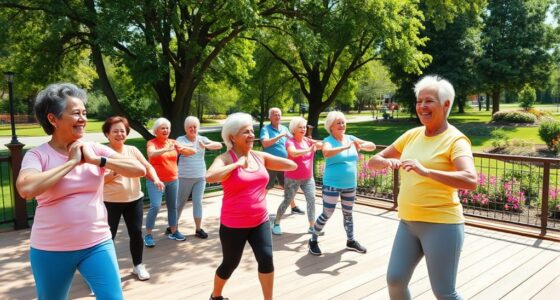Weight training is essential for seniors over 70 to stay strong and independent. Start with bodyweight exercises like squats and wall push-ups to build confidence and muscle strength. Use resistance bands for safe, adjustable workouts that target all major muscle groups. Aim for strength training twice a week, and incorporate balance exercises to enhance stability. Always check with your doctor before starting any new routine. There’s more valuable information on how to create an effective strength training plan!
Key Takeaways
- Start with bodyweight exercises like squats and wall pushups to build strength safely and effectively.
- Gradually introduce resistance bands for adjustable resistance workouts that enhance muscle strength and mobility.
- Focus on proper form to prevent injuries and build confidence in your strength training routine.
- Aim for at least two strength training sessions a week, gradually increasing duration from 10 to 15 minutes.
- Incorporate balance exercises three times a week to improve stability and reduce fall risk.
Understanding the Importance of Strength Training for Seniors

Strength training is crucial for seniors, as it greatly enhances overall well-being and independence. For older adults, engaging in regular strength training markedly improves muscle strength, making everyday tasks—like lifting groceries or playing with grandchildren—much easier. Additionally, developing a growth mindset can help seniors embrace the challenges of strength training, leading to greater resilience and motivation. Furthermore, implementing risk management strategies in exercise routines can help prevent injuries and ensure safe practices. Regular strength training also promotes healthy bones, which is vital for maintaining mobility and reducing the risk of fractures. Incorporating nutritional support into a strength training regimen can further enhance overall health and recovery.
This resistance training not only boosts your quality of life but also plays an essential role in enhancing cardiovascular health, reducing the risk of heart attack or stroke by up to 70%.
Additionally, strength training increases bone density, lowering the risk of osteoporosis and fractures. By improving mobility and balance, it helps you maintain independence as you age, ultimately leading to a healthier, more active lifestyle.
Strength training boosts bone density and balance, ensuring independence and a vibrant, active lifestyle as you age.
Prioritizing strength training guarantees you stay strong and resilient throughout your golden years. Moreover, long-term financial planning for assisted living needs can further support your ability to engage in these vital activities.
Essential Guidelines for Starting Strength Training

When you start strength training, it’s best to begin with bodyweight exercises like lunges and wall pushups. Focusing on proper form helps you build confidence and reduces the risk of injury. As you progress, you can gradually introduce light weights or resistance bands to enhance your strength. Additionally, incorporating educational and skill-building toys into your routine can help improve your overall coordination and balance. Including high-protein meals in your diet, such as the Turkey Bean and Tomato Zoodle Bowl, can support muscle recovery and growth. Moreover, it’s important to recognize that developmental milestones in older adults can influence the effectiveness of your training regimen. Engaging in strength training can also lead to improved overall health benefits such as increased muscle mass and better bone density. Incorporating chia seeds into your meals can provide essential nutrients that support your overall strength training efforts.
Begin With Bodyweight Exercises
Starting your strength training journey with bodyweight exercises is a smart choice, as it helps you master proper form and build foundational strength.
Begin with exercises like squats, wall pushups, and lunges, aiming for three sets of 10 to 15 repetitions. This approach targets major muscle groups and enhances functional strength, making everyday tasks easier. Engaging in physical activity promotes overall health and well-being, supporting your strength training goals. Regularly checking and cleaning filters on your air purifier can improve air quality in your workout space, enhancing air quality considerations and supporting your strength training efforts. Additionally, maintaining safe sleep practices can contribute to your overall recovery and energy levels, which are crucial for effective workouts. Incorporating natural remedies like proper hydration can also aid in muscle recovery and overall performance.
By focusing on these movements, you promote injury prevention and boost your confidence as you progress.
Once you feel comfortable, gradually incorporate light weights or resistance bands to further challenge yourself while guaranteeing you maintain good form.
If you’re new to strength training, consider working with a personal trainer for personalized guidance to ensure safe execution of each exercise. Additionally, engaging in interactive learning toys can enhance your coordination and balance, further supporting your fitness journey.
Focus on Proper Form
To guarantee a safe and effective strength training experience, focusing on proper form is essential, especially as you age. Start with bodyweight exercises to build confidence and gradually master basic movements like lunges and wall pushups. Additionally, incorporating sustainable fashion principles into your workout gear can enhance comfort and support your health journey. Understanding the importance of proper form can significantly reduce the risk of injury during your workouts. Engaging in mindfulness practices can also improve your focus and awareness during training sessions.
This beginner’s guide helps you establish a solid foundation before progressing to weighted workouts. Consider working with a personal trainer who can provide valuable insights into maintaining proper form, ensuring you perform exercises correctly for maximum benefits and injury prevention. Additionally, focusing on strong communication skills with your trainer can enhance your understanding of exercise techniques.
Remember to engage in post-workout monitoring; while some soreness is normal, sharp pain signals a need to reassess your technique. Additionally, fresh orange juice can improve hydration and recovery post-workout. By prioritizing form, you’ll enhance your strength training journey and enjoy the benefits of improved health and mobility.
Recommended Exercises for Building Strength

When it comes to building strength, incorporating bodyweight exercises like squats and incline push-ups can be a great start. Resistance band workouts also offer adjustable resistance, making them perfect for gentle yet effective strength training. Additionally, focusing on personal and community resilience can motivate seniors to stay committed to their fitness routines.
Bodyweight Exercises Benefits
While many seniors may think they need equipment to build strength, bodyweight exercises offer an effective and accessible solution. These exercises, like squats and incline pushups, help improve strength without the need for weights, making them safe and easy to perform.
They engage multiple muscle groups, enhancing mobility and balance, which is essential for reducing the risk of falls. Additionally, bodyweight exercises maintain functional movements necessary for daily activities, such as standing up from a chair.
Starting with these movements allows you to focus on proper form and build foundational strength, combating age-related muscle loss. Regularly engaging in bodyweight exercises promotes overall physical health and keeps your bones strong, empowering you to stay active and independent.
Resistance Band Workouts
Resistance band workouts are a fantastic way for seniors to build strength safely and effectively. These low-impact exercises provide adjustable resistance, making them perfect for strength training without the risk of injury linked to free weights.
You can target various muscle groups, allowing for versatile full-body workouts that enhance muscle strength and functional mobility. Start with lighter bands to master proper form, then gradually increase resistance as you gain confidence.
Incorporating simple exercises like seated rows, chest presses, and leg extensions at least twice a week can greatly aid in fall prevention and improve overall strength. Plus, resistance bands are joint-friendly, making them an excellent choice for maintaining strength as you age.
Essential Strength Training Moves
Building on the benefits of resistance band workouts, incorporating a variety of strength training moves can further enhance your fitness routine.
Start with squats, which build lower body strength and can be modified with chair support for accessibility. Incline pushups against a wall or table allow you to gradually increase strength while maintaining proper form.
Seated rows using resistance bands effectively strengthen your upper back and improve posture, essential for stability. Stationary lunges enhance leg strength and can be adjusted for support.
Finally, the Dead Bug exercise promotes core strength and stability; you can bend your legs to make it easier.
These exercises not only keep you strong but also boost your confidence in daily activities.
Tips for Maintaining a Regular Training Schedule

To maintain a regular training schedule, it’s essential to create a routine that fits comfortably into your lifestyle. Aim for strength training sessions at least twice a week, using non-consecutive days for recovery.
Start with 10 to 15-minute sessions and gradually increase the duration as your strength and endurance improve. Incorporate balance activities three times a week to enhance stability and prevent falls.
Establish personal motivations, like maintaining independence or enjoying family activities, to keep you committed. Consider joining group fitness classes designed for older adults, such as those offered by SilverSneakers, to stay engaged and benefit from supportive instructors.
These steps will help you reap the health benefits of a consistent exercise program and boost your overall physical activity.
Safety Considerations and Risk Management

When starting on a strength training program, it’s critical to prioritize safety and risk management, especially for seniors. First, consult with a doctor or physical therapist to address any health conditions, like osteoporosis.
Focus on proper form to prevent injuries; consider working with a trainer experienced in senior fitness. Begin with bodyweight exercises or light weights, allowing for gradual progression as your strength improves.
Incorporate balance activities at least three times a week to help reduce fall risks. After workouts, monitor your post-workout feelings—while muscle soreness is normal, sharp pain could indicate improper form or overexertion.
Exploring SilverSneakers Resources for Support

Finding the right support can make a significant difference in your strength training journey. SilverSneakers offers a wealth of resources tailored specifically for seniors like you.
With access to thousands of fitness locations nationwide, you can join instructor-led classes such as SilverSneakers Classic and Bodyweight Boot Camp, designed to help you build strength in a supportive environment.
If you prefer working out at home, SilverSneakers LIVE online classes are available at no extra cost, ensuring you can stay active no matter where you are.
Plus, there are over 200 free On-Demand videos to explore at your convenience.
Check your eligibility through Medicare Advantage to tap into these valuable resources and enhance your fitness journey today.
Frequently Asked Questions
What Is the Best Strength Training for a 70 Year Old?
The best strength training for a 70-year-old includes bodyweight exercises, resistance bands, and light weights.
You should focus on exercises like squats, incline pushups, and seated rows, ensuring you maintain proper form.
Aim to train at least twice a week, targeting major muscle groups to boost mobility and balance.
Gradually increase intensity while listening to your body.
And don’t forget, consulting with a healthcare provider before starting is essential for your safety.
How Many Times a Week Should a 70 Year Old Lift Weights?
You should aim to lift weights at least twice a week to maintain your strength and functional abilities.
If you’re feeling up for it, training three to four times a week can provide even better results.
Just remember to take breaks between sessions, allowing your muscles to recover.
Start with shorter sessions of 10-15 minutes, gradually increasing the duration and intensity as you feel stronger and more comfortable with the exercises.
How Can I Build Muscle Strength After 70?
To build muscle strength after 70, you should engage in strength training at least twice a week.
Start with bodyweight exercises like squats and pushups to master your form, then gradually add light weights or resistance bands. Aim for three sets of 10 to 15 repetitions.
Don’t forget to incorporate balance activities three times weekly to enhance stability.
Always listen to your body and consult a professional to tailor a program that suits your needs.
How Can I Stay Strong After 70?
Think of your body as a classic car that needs regular maintenance to keep running smoothly.
To stay strong after 70, engage in strength training at least twice a week. Start with bodyweight exercises or light weights, aiming for three sets of 10 to 15 reps. Focus on key movements like squats and incline pushups.
Join group classes for motivation, and always check in with your doctor to tailor your routine safely.
Conclusion
In the journey of life, strength training is your sturdy walking stick, helping you navigate the winding paths of aging with confidence and grace. By embracing these tips and exercises, you’re not just building muscle; you’re fortifying your spirit and enhancing your energy. Remember, every rep is a step toward independence and joy. So, lace up those sneakers and take charge—your strength is the key to releasing a vibrant, active life in your golden years.









